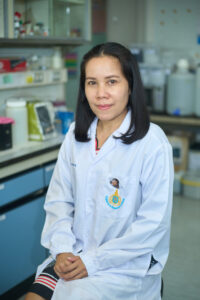Ms. Sumontha Nookabkaew

Name: Miss Sumontha Nookabkaew
Office address: Laboratory of Pharmacology, 4 th Floor, Biomedical Science Building
54 Kamphaeng Phet 6 Talat Bang Khen, Lak Si, Bangkok 10210, Thailand
Tel: +66 2553 8555 (ext. 3161)
E-mail: 
Position: Research Scientist I
Research Interests
• Heavy metals in food, environmental and biological samples, Arsenic speciation
Education
• Master degree in Applied Analytical and Inorganic Chemistry, Mahidol University
• Bachelor degree in Chemistry, Prince of Songkla University
Area of expertise
• Inductively Coupled Plasma Mass Spectrometry (ICP-MS), Atomic Absorption Spectrometry (AAS), Microwave digestion
Publications
•Sodium arsenite exposure impairs B cell proliferation and enhances vascular inflammation in Plasmodium berghei mouse model
Suntararuks S, Worasuttayangkurn L, Akanimanee J, Suriyo T, Nookabkaew S, ,Srisamut N, Visitnonthachai D, Watcharasit P, Satayavivad J.
Environ Toxicol Pharm. 2019; 66: 7-13.
• Arsenic speciation and accumulation in selected organs after oral administration of rice extracts in Wistar rats.
Lewchalermvong K,Rangkadilok N, Nookabkaew S, Suriyo T, Satayavivad J.
J Agric Food Chem. 2018, 66: 3199-3209.
• Hijiki and sodium arsenic stimulate growth of human colorectal adenocarcinoma cells through ERK1/2 activation.
Cholpraipimorat W, Suriyo T, Rangkadilok N, Nookabkaew S, Satayavivad J.
Food Chem Toxicol 2017; 110: 33-41.
• Concentrations of trace elements in organic fertilizers and animal manures and feeds and cadmium contamination in herbal tea (Gynostemma pentaphyllum Makino).
Nookabkaew S, Rangkadilok N, Prachoom N., Satayavivad J.
J Agric and Food Chem 64 p3119-26 (2016)
• Arsenic, cadmium, and manganese levels in shellfish from Map Ta Phut, an Industrial area in Thailand, and the potential toxic effects on human cells.
Rangkadilok N, Siripriwon P, Nookabkaew S, Suriyo T, Satayavivad J.
Arch Environ Contam Toxicol. 2015; 68:169-180.
• Control of zinc homeostasis in Agrobacterium tumefaciens via zur and the zinc uptake genes znuABC and zinT.
Bhubhanil S, Sittipo P, Chaoprasid P, Nookabkaew S, Sukchawalit R, Mongkolsuk S.
Microbiology. 160, 2014, 2452–2463.
• Determination of arsenic species in rice from Thailand and other Asian countries using simple extraction and HPLC-ICP-MS analysis.
Nookabkaew S, Rangkadilok N, Mahidol C, Promsuk G, Satayavivad J.
J Agric Food Chem. 2013; 61:6991-8.
• Evaluation of trace elements in selected foods and dietary intake by young children in Thailand.
Nookabkaew S, Rangkadilok N, Akib CA, Tuntiwigit N, Saehun J, Satayavivad J.
Food Addit Contam B. 2013; 6:55-67.
• Variation of sesamin, sesamolin and tocopherols in sesame (Sesamum indicum L.) seeds and oil products in Thailand.
Rangkadilok N, Pholphana N, Mahidol C, Wongyai W, Saengsooksree K, Nookabkaew S, Satayavivad J.
Food Chemistry. 2012; 122:724-30.
• Immunomodulatory effects of cadmium and Gynostemma pentaphyllum herbal tea on rat splenocyte proliferation.
Suntararuks S, Yoopan N, Rangkadilok N, Worasuttayangkurn L, Nookabkaew S, Satayavivad J.
J Agric Food Chem. 2008; 56:9305-11.
• Activation of inflammation/NF-kappaB signaling in infants born to arsenic-exposed mothers.
Fry RC, Navasumrit P, Valiathan C, Svensson JP, Hogan BJ, Luo M, Bhattacharya S, Kandjanapa K, Soontararuks S, Nookabkaew S, Mahidol C, Ruchirawat M, Samson LD.
PLoS Genet. 2007; 3:2180-9.
• Determination of trace elements in herbal tea products and their infusions consumed in Thailand.
Nookabkaew S, Rangkadilok N, Satayavivad J.
J Agric Food Chem. 2006; 54:6939-44.





